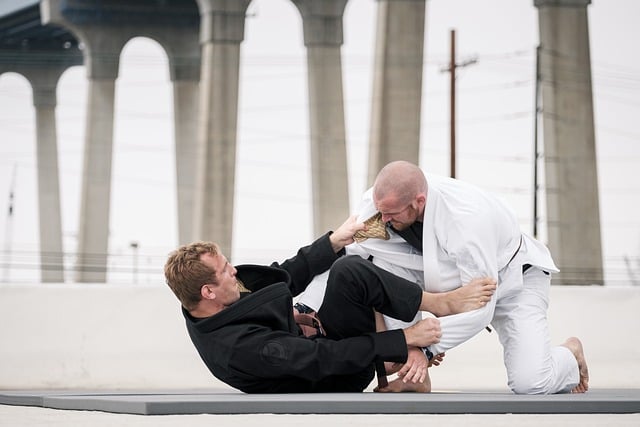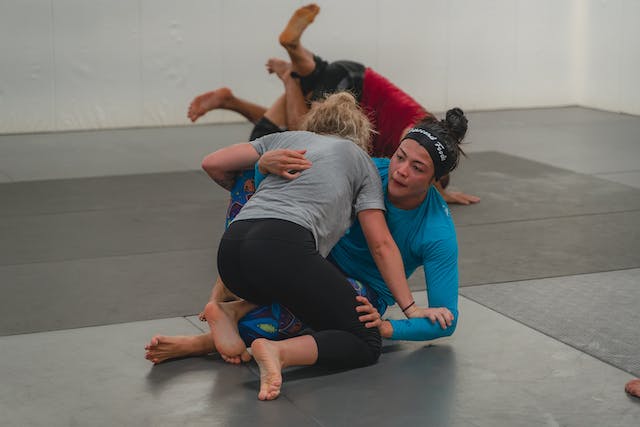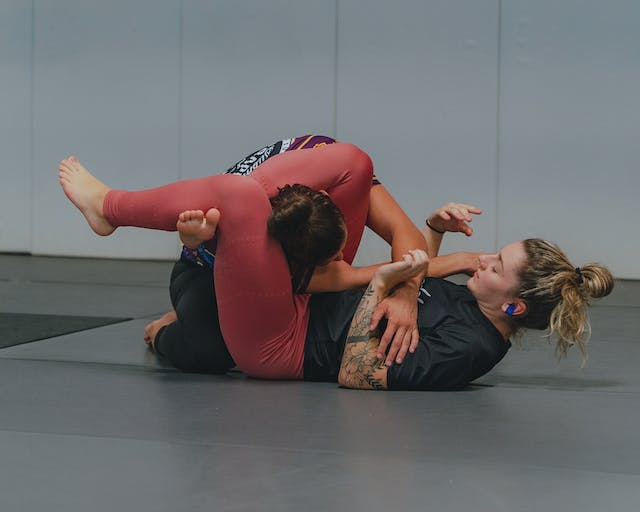Brazilian Jiu-Jitsu (BJJ) is a martial art that has its origins in Brazil and focuses mostly on grappling techniques. Due to its efficacy in competition, self-defense, and fitness, it has become quite popular all over the world.

History
Known for their skill in Japanese Judo, the Gracie family created BJJ in the early 1900s. To establish BJJ, they modified Judo, emphasizing the use of technique and leverage over brute force when taking on bigger opponents. Because of this, BJJ is a martial art that people of all ages and sizes can practice.
Is it distinct?
A special kind of BJJ is ground combat, where students learn how to take down their opponents and submit them using joint locks and chokeholds. Other martial arts, including karate and taekwondo, on the other hand, place greater emphasis on striking methods. Being a martial art that emphasizes leverage and ground combat, BJJ is a well-liked choice for self-defense. Practicing BJJ allows practitioners to eliminate assailants without resorting to excessive force by dominating their opponents on the ground. In addition to being physically taxing, BJJ training may improve general fitness, strength, and endurance.
BJJ is another well-liked sport that has both amateur and professional divisions in its competitive scene. Top competitors from all around the globe participate in various contests, such the globe Championships. Age, weight, and ability level categories enable BJJ practitioners of all levels to compete on an even playing field.
principal idea Jiu-Jitsu
The fundamental tenet of BJJ is technique wins over strength, meaning that smaller or weaker practitioners may defeat stronger opponents by using the right technique and leverage. Because of this idea, BJJ is now widely practiced by women who may not be as physically strong as males.

In conclusion, BJJ is a successful martial art that has become well-known across the world because it places a strong focus on ground combat, leverage, and technique. As such, it is suitable for people of all ages and sizes. Drilling and sparring are often used in BJJ classes, with safety precautions taken to avoid accidents.
Like other martial arts, BJJ has a system of belt rankings, ranging from white to black, with progress determined on training duration and technical proficiency.
In addition to its physical advantages, BJJ training may help practitioners mentally by lowering stress and anxiety, increasing focus, sharpening problem-solving abilities, and building mental resilience via flexibility.
Is it combat sports?
It is a distinctive and powerful martial art that is becoming more and more well-liked globally. BJJ places a strong emphasis on humility and respect, fostering an accepting and encouraging training atmosphere for individuals from all walks of life. Children may gain confidence, discipline, and physical health via BJJ training. Law enforcement and military professionals can also modify the technique for application in real-life scenarios. BJJ practitioners often develop personal relationships and a feeling of belonging to a broader community of BJJ practitioners, contributing to the sport’s strong sense of community and camaraderie.
In general, Brazilian Jiu-Jitsu is a martial art that may benefit all skill levels and be used for self-defense, athletics, physical fitness, and community development. The adaptable martial art of Brazilian Jiu-Jitsu (BJJ) is becoming more and more well-known around the globe because of its efficiency and inclusion. It helps individuals of all ages, genders, and physical capacities in terms of self-defense, sports, and fitness.
“Position before submission,” a fundamental tenet of BJJ, stresses gaining dominating positions over opponents before to attempting submissions. It’s crucial to train with a range of partners in BJJ to build a diverse skill set and avoid injuries. In other combat sports, such mixed martial arts (MMA), BJJ has also been effectively used, with several elite fighters using BJJ tactics. BJJ has a rich cultural past in addition to its practical uses.

The creators of the art, the Gracie family, are renowned in the martial arts community. BJJ also has its own distinctive customs, such the bowing ritual and gi use. To sum up, BJJ is a flexible martial art that emphasizes positional control, partner training, and real-world applications in many combat sports. Its attractiveness and enduring popularity are enhanced by its inclusiveness and cultural customs. Brazilian Jiu-Jitsu is a complex and multifaceted martial art with an intriguing past and present.
Whether for self-defense, health, or sport, its emphasis on leverage, technique, and ground combat makes it a special and useful discipline that offers many advantages to practitioners of all ages, genders, and abilities. Competition in BJJ helps practitioners test and improve their skills, monitor their development, and build relationships with the larger BJJ community. BJJ is still becoming more and more popular globally. Moreover, BJJ is a well-liked option for self-defense instruction due to its useful methods and focus on real-world situations. Its methods, which include takedowns, joint locks, and chokes, may be successful in real-world scenarios and provide practitioners the abilities and self-assurance to defend oneself in a variety of settings. Brazilian Jiu-Jitsu is a diverse martial art that is becoming more and more well-known.
It places a strong emphasis on respect, humility, and personal development. Because of its emphasis on technique, leverage, and ground combat, Brazilian Jiu-Jitsu (BJJ) is a powerful and distinctive martial art that offers its practitioners many advantages for self-defense, sport, or personal development. BJJ is distinct in that it places a strong focus on sparring, or rolling. Sparring offers a safe and regulated environment in which practitioners may assess their progress and pinpoint areas for growth while honing their timing, reflexes, and decision-making abilities.
Training in BJJJ may benefit mental health as well. BJJJ practitioners discover that the mental and physical demands of the sport lower stress and enhance general wellbeing. Furthermore, the friendships and sense of community that form among training partners may provide a safety net and a feeling of inclusion. Training in BJJ may be customized to accommodate a range of objectives and degrees of fitness. BJJ provides a demanding and fulfilling training environment for anybody looking to get in shape, learn self-defense techniques, or participate in competitions. The distinct concept of BJJ promotes humility, respect, and personal development that can be applied outside of the mat to various facets of one’s life.
Brazilian Jiu-Jitsu (BJJ) has been well-known for its efficacy in mixed martial arts (MMA) throughout time. Many elite mixed martial artists have experience with Brazilian Jiu Jitsu (BJJ). They use their grappling abilities to dominate and submit opponents. BJJ moves like the armbar, rear naked choke, and triangle choke have become standard practice in the MMA community.
BJJ is a complete martial art that provides its practitioners with a wide array of benefits. It is a remarkable and effective martial art that is becoming more and more well-known across the world because to its technique, leverage, and emphasis on ground combat. Whether it’s for self-defense, sports, or personal growth, BJJ meets everyone’s requirements and inspires and challenges people of all ages and abilities.
The focus of BJJ training is on physical fitness; sparring offers a comprehensive exercise that strengthens many muscle groups and improves cardiovascular endurance. Balance, coordination, and agility are all enhanced by the sparring’s rapid movements and continuous weight shifting.
In addition to its physical advantages, BJJ offers a host of psychological and emotional advantages. Because mastering BJJ techniques requires focus and discipline, practitioners may develop resilience and mental fortitude. The camaraderie and support of the BJJ community may give people a feeling of connection and belonging, especially for those who experience social anxiety or isolation.
BJJ practitioners are urged to follow the rules and customs of the art, as well as to show respect for their teachers and training partners. The art puts a high emphasis on discipline and respect. This focus on discipline and respect may be applied outside of the mat to all facets of life, which fosters personal development.
Finally, the Gracie family, who created the art, has influenced BJJ’s distinct history and culture. The Gracies are credited with starting the contemporary martial arts movement and greatly influencing the rise in popularity of BJJ. BJJ is one of the most well-known and recognized martial arts in the world because to the Gracie family’s dedication to the craft and desire to teach the next generation.
To sum up, Brazilian Jiu-Jitsu is a demanding and rewarding martial art that offers a host of advantages to those who practice it. It is a distinct and powerful martial art that can be adjusted to match a range of fitness levels and objectives because of its emphasis on technique, leverage, and ground combat. Regardless of age or ability level, BJJ keeps inspiring and testing people for sport, self-defense, or personal development.
official maximum age
Since anybody of any age may practice Brazilian Jiu-Jitsu, there isn’t an official age restriction. A lot of schools and gyms provide lessons for people of all ages in addition to kid-specific activities. Before beginning any new physical activity, you should speak with a physician or other healthcare provider, particularly if you have any prior injuries or medical concerns. Finding a respectable and knowledgeable teacher is also crucial since they can guarantee that, at whatever age you are training, you are doing it safely and appropriately. Read more
Mastering the Art of Kickboxing: Techniques, Benefits, and Training Tips